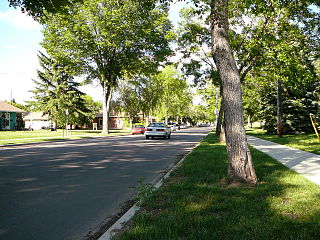Greenfield, formerly known as Petrolia, is a residential neighbourhood located in southwest Edmonton, Alberta, Canada. There is a small shopping centre, Petrolia Shopping Centre, located in the neighbourhood. The neighbourhood was named for Herbert Greenfield, the Premier of Alberta from 1921 to 1925, during the reign of the United Farmers of Alberta political party.
Eastwood is a residential neighbourhood in north central Edmonton, Alberta, Canada. It is one of Edmonton's older neighbourhoods, with development starting in 1906. Today, most of the residential construction (88%) dates from after World War II.
Parkdale is a central neighbourhood in Edmonton, Alberta, Canada located a short distance north of the downtown core. Located to the south of the neighbourhood is Commonwealth Stadium and to the north east is Northlands Coliseum. Parkdale is part of the Norwood area of Edmonton.

Holyrood is a residential neighbourhood in the Bonnie Doon area of south east Edmonton, Alberta, Canada. The name, Holyrood, is an anglicisation of the Scots haly ruid.
Westwood is a residential neighbourhood in north central Edmonton, Alberta, Canada. It is bounded by Yellowhead Trail to the north, 107 Street and 106 Street to the west, 118 Avenue to the south, 97 Street to the east. The Edmonton City Centre Airport is located to the west, while the Northern Alberta Institute of Technology and Kingsway Mall are located to the southwest.
Royal Gardens is a residential neighbourhood in south west Edmonton, Alberta, Canada. The neighbourhood is bounded on the north by Whitemud Drive, on the east by 111 Street, on the south by 40 Avenue, and on the west by 119 Street/121 Street.
Montrose is a residential neighbourhood in north east Edmonton, Alberta, Canada.
Newton is a residential neighbourhood located in north east Edmonton, Alberta, Canada. It is named for Reverend William Newton who arrived in Edmonton in 1875. The Anglican canon served the people of Edmonton until 1900. The Hermitage, a hospital he founded just east of the old town, is now the Hermitage area of Edmonton. The neighbourhoods of Newton and Canon are named after him.
Pleasantview is a residential neighbourhood in south west Edmonton, Alberta, Canada.
Blue Quill is a residential neighbourhood located in south west Edmonton, Alberta, Canada. Blue Quill and the adjacent neighbourhood of Blue Quill Estates are named to honour Chief Blue Quill of the Saddle Lake Band.
Empire Park is a residential neighbourhood in southwest Edmonton, Alberta, Canada. A major shopping centre, Southgate Centre, is located at the west end of the Neighbourhood.
Sifton Park is a residential neighbourhood in the Clareview area of north east Edmonton, Alberta, Canada. The neighbourhood was named for Arthur Sifton, who served as the second premier of Alberta from 1910 until 1917.
King Edward Park is a residential neighbourhood on south east Edmonton, Alberta, Canada. The neighbourhood was originally annexed by Edmonton in 1912.

Prince Charles is a residential neighbourhood in north west Edmonton, Alberta. The area was named in honour of Charles III, then known as Prince Charles.
Canon Ridge is a residential neighbourhood in the Hermitage area of north east Edmonton, Alberta, Canada that was mostly built up in the 1950s.
Homesteader is a residential neighbourhood in the Hermitage area of north east Edmonton, Alberta, Canada.
Killarney is a residential neighbourhood located in north east Edmonton, Alberta, Canada. While the area became part of Edmonton in 1913, residential development did not occur until the 1950s and 1960s.
Kilkenny is a residential neighbourhood in north east Edmonton, Alberta, Canada. Most of the development in the neighbourhood occurred during the 1960s and 1970s. It was named after Kilkenny in Ireland.
Ermineskin is a residential neighbourhood in south west Edmonton, Alberta, Canada. The neighbourhood is named for Chief Ermineskin of Maskwacis.
Rideau Park is a residential neighbourhood in southwest Edmonton, Alberta, Canada. The name Rideau means curtain in the French Language.


